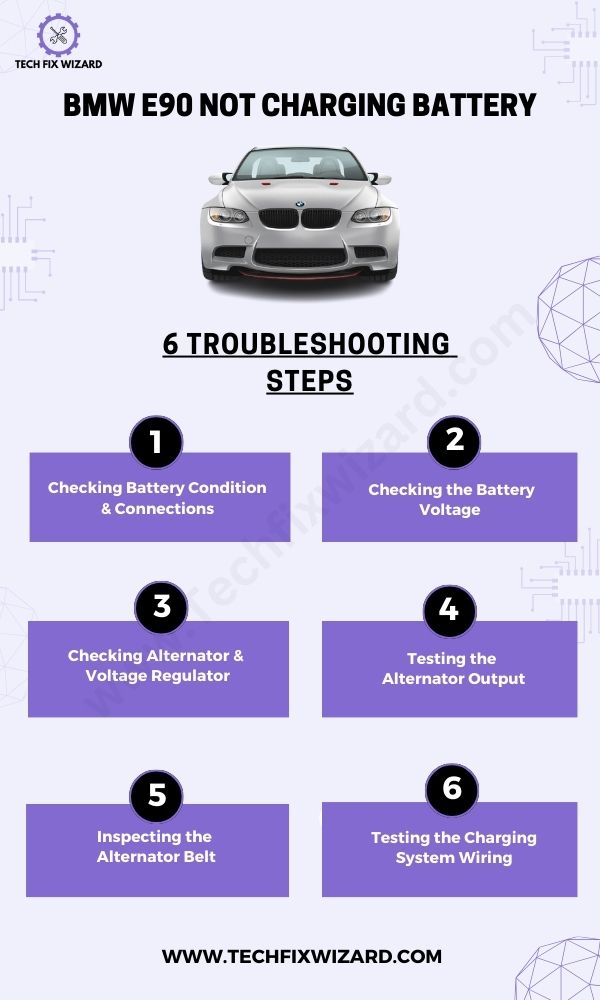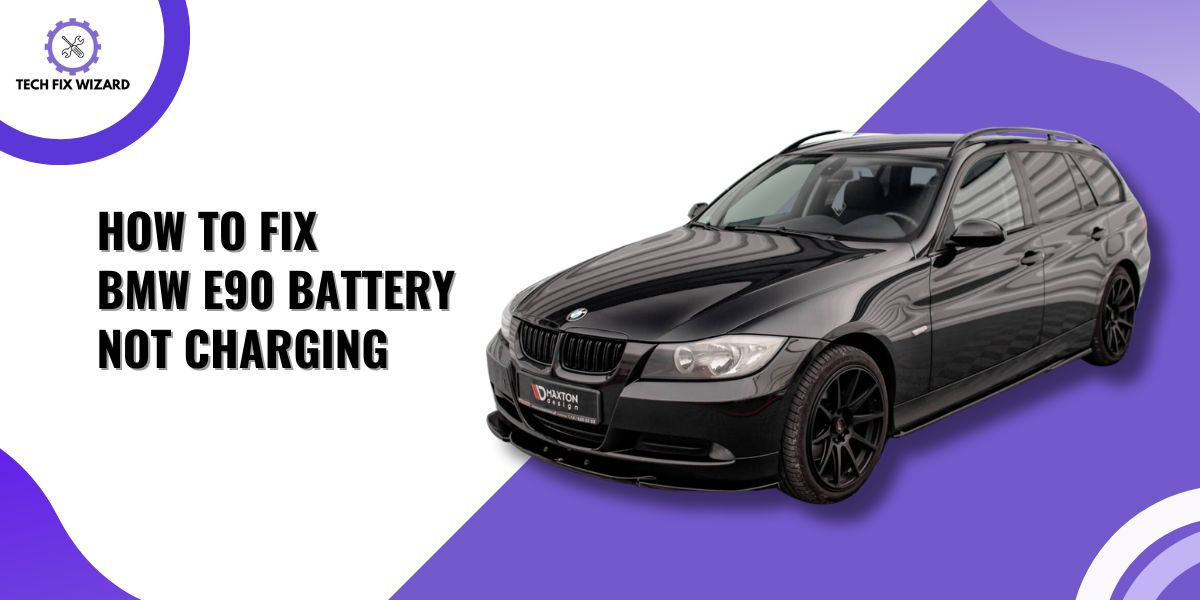The BMW E90 is a popular luxury sedan known for its performance and style. However, like any vehicle, it can encounter various electrical issues over time.
The BMW E90 not charging battery issue is a common issue which is faced by its owners.
In this article, we will explore some possible causes behind the issue of the BMW E90 not charging the battery and suggest potential solutions to help diagnose and rectify the issue.
Let’s get started!
Contents
- 1 BMW E90 Not Charging Battery – Possible Causes
- 2 Troubleshooting BMW E90 Not Charging Battery – 6 Easy Steps
- 3 1. Checking Battery Condition and Connections
- 4 2. Checking the Battery Voltage
- 5 3. Inspecting the Alternator and Voltage Regulator
- 6 4. Testing the Alternator Output
- 7 5. Inspecting the Alternator Belt
- 8
- 9 6. Testing the Charging System Wiring
- 10 BMW E90 Not Charging Battery – Repairs
- 11 1. Replacing the Battery
- 12 2. Replacing the Alternator
- 13 4 Tips for Maintaining Your BMW E90 Battery
- 14 FAQs
- 15 Why is my BMW E90 not charging the battery?
- 16 How can I determine if the alternator is the problem?
- 17 What should I do if the alternator is not charging the battery?
- 18 Can a defective voltage regulator cause the battery not to charge?
- 19 How can I check the battery’s condition?
- 20 Can a broken or loose alternator belt affect the battery charging?
- 21 What are common signs of battery issues?
- 22 Can faulty wiring or connections cause the battery not to charge?
- 23 Should I replace the battery if it’s not holding a charge?
- 24 Can a dead battery be recharged?
- 25 How can I prevent battery charging issues in the future?
- 26 Official References & Resources
BMW E90 Not Charging Battery – Possible Causes
When facing the BMW E90 not charging battery issue, it is crucial to investigate the potential causes to address the issue effectively.
Following is the list of the 5 possible causes of the BMW E90 not charging battery issue:
| Possible Causes | Description |
|---|---|
| 1. Faulty alternator | The alternator may be unable to generate sufficient electricity to charge the battery. |
| 2. Defective voltage regulator | A faulty voltage regulator can result in overcharging or undercharging of the battery. |
| 3. Broken or loose alternator belt | If the alternator belt is broken or loose, the alternator may not rotate properly for charging. |
| 4. Battery issues | Old, damaged, or dead batteries may not hold a charge, preventing proper charging. |
| 5. Faulty wiring or connections | Loose connections, damaged wires, or faulty connectors can disrupt the charging process. |
Troubleshooting BMW E90 Not Charging Battery – 6 Easy Steps
When faced with the BMW E90 not charging battery issue, there are several troubleshooting steps you can take to diagnose and potentially resolve the problem.
By following these steps, you can systematically identify and address the underlying causes:

1. Checking Battery Condition and Connections
When troubleshooting a BMW E90 not charging the battery, checking the battery condition and connections is a crucial step.
Follow the steps below to thoroughly assess the battery’s condition and connections, ensuring they are in proper working order for efficient charging in the BMW E90.
- Examine the battery for physical damage, such as cracks or bulges.
- Check for leaks and corrosion around the battery terminals.
- Clean the battery terminals if corrosion is present, using a mixture of baking soda and water or a terminal cleaner.
- Ensure tight connections by securely tightening the battery terminals.
- Inspect the battery cables for fraying, damage, or loose connections.
- Replace damaged cables or repair loose connections as needed.
- Perform a battery load test to assess its health and capacity.
2. Checking the Battery Voltage
Checking the battery voltage is the second step in our troubleshooting process for addressing the BMW E90 not charging battery issue.
By examining the battery’s voltage, we can gain crucial insights into its condition and whether it may be contributing to the charging problem.
| Troubleshooting Steps | Description |
|---|---|
| 1. Safety first | Ensure the engine is turned off, and the key is removed from the ignition. |
| 2. Locate the battery | Find the battery in the trunk or engine compartment. |
| 3. Open the battery compartment | Remove any covers or panels to access the battery terminals. |
| 4. Check the battery voltage | Use a multimeter set to DC voltage. Connect the probes to the battery terminals. |
| 5. Read the voltage | Measure the voltage, which should be around 12.6 to 12.8 volts when the vehicle is not running. |
| 6. Test the battery under load | Have an assistant try to start the vehicle while measuring the voltage. |
| 7. Battery condition | Assess if the battery voltage is within the acceptable range and stable under load. |
3. Inspecting the Alternator and Voltage Regulator
The third step in the troubleshooting process for the BMW E90 not charging the battery is inspecting the alternator and voltage regulator.
This crucial step involves a comprehensive examination of these components to identify any potential issues.
- Perform a visual inspection of the alternator and voltage regulator components.
- Look for physical damage, such as cracks, dents, or loose connections.
- Inspect the wiring connections and ensure they are securely attached.
- Test the voltage regulator terminals using a multimeter.
- Pay attention to any abnormal noises or smells coming from the alternator.
- Consider utilizing professional diagnostic tools for a more comprehensive assessment.
4. Testing the Alternator Output
After checking the battery voltage, the next step in troubleshooting the BMW E90’s charging issue is to test the alternator output.
The alternator is responsible for generating electrical power and charging the battery while the engine is running. Here’s how you can test the alternator output:
| Testing the Alternator Output: Steps | Description |
|---|---|
| 1. Start the engine | Ensure the vehicle is in a well-ventilated area and start the engine. |
| 2. Turn off electrical loads | Disable any electrical accessories like headlights, air conditioning, and stereo to reduce the load on the alternator. |
| 3. Set the multimeter | Configure the multimeter to DC voltage and select an appropriate range (at least 15 volts). |
| 4. Connect the multimeter | Attach the positive (red) probe of the multimeter to the battery’s positive terminal (+) and the negative (black) probe to the negative terminal (-). |
| 5. Measure battery voltage | Record the voltage reading on the multimeter while the engine is running. |
| 6. Rev the engine | Have an assistant increase the engine speed to approximately 2000-3000 RPM. |
| 7. Observe voltage reading | Monitor the multimeter to note how the voltage changes as the engine speed increases. |
| 8. Note any abnormalities | Take note of any voltage readings outside the expected range or significant fluctuations, indicating potential alternator or component issues. |
5. Inspecting the Alternator Belt
Inspecting the alternator belt is an essential step in troubleshooting the charging system of a BMW E90.
Following are the steps for the inspection of the Alternator belt:
| Step | Inspecting the Alternator Belt |
|---|---|
| 1. | Check the condition of the alternator belt for signs of wear, cracking, or looseness. |
| 2. | Ensure that the belt is properly tensioned and seated on the alternator pulley. |
| 3. | If the belt is damaged or loose, consider adjusting or replacing it to ensure proper alternator rotation. |
6. Testing the Charging System Wiring
Testing the charging system wiring is typically one of the final steps in troubleshooting the BMW E90’s charging issue.
Prioritizing other potential causes, such as a faulty battery, alternator, or voltage regulator, helps rule out issues unrelated to the wiring.
By focusing on the wiring last, you can ensure that any charging problems are not stemming from the charging system itself.
| Testing the Charging System Wiring: Steps | Description |
|---|---|
| 1. Visual inspection | Visually inspect the wiring harness and connectors associated with the charging system for damage, loose connections, or frayed wires. |
| 2. Check for loose connections | Gently wiggle and tug on the wiring and connectors to check for any movement or play. Tighten connections as needed for a secure fit. |
| 3. Examine for frayed wires | Look for signs of fraying, especially near areas where the wiring harness may come into contact with sharp edges or moving components. |
| 4. Test for continuity | Set the multimeter to the continuity or resistance mode.
Test for continuity by connecting one probe to a known good ground and touching various points along the charging system wiring. |
| 5. Test for voltage drops | Set the multimeter to DC voltage. Connect the positive (red) probe to the battery’s positive terminal and the negative (black) probe to different points along the charging system wiring. |
| 6. Check critical connections | Pay close attention to critical connections such as the alternator terminal, battery terminals, and fusible links.
Ensure they are clean, corrosion-free, and making solid contact. |
| 7. Repair or replace damaged components | If any damaged wiring, connectors, or components are identified, repair or replace them as needed.
Use appropriate wire connectors and insulation for secure and reliable repairs. |
BMW E90 Not Charging Battery – Repairs
If you have pinpointed issues with the battery or alternator and are considering replacing them, follow the instructions below for a successful replacement.
1. Replacing the Battery
Follow the steps below to replace your battery if it requires replacement to resolve the BMW E90 not charging issue:
| Step | Description |
|---|---|
| 1. Gather the necessary tools | Wrench or socket set, gloves, and safety glasses. |
| 2. Locate the battery | Typically in the trunk, under the carpet, or a cover. Refer to the vehicle’s manual for precise location. |
| 3. Prepare for battery replacement | Turn off the engine and electrical components. Put on gloves and safety glasses. |
| 4. Disconnect the negative terminal | Loosen the nut and remove the cable from the negative terminal (-). |
| 5. Disconnect the positive terminal | Loosen the nut and remove the cable from the positive terminal (+). |
| 6. Remove the battery | Check for securing brackets or straps. Lift the battery out of its compartment. |
| 7. Clean the battery compartment | Inspect and clean the compartment using a battery cleaner or baking soda mixture. |
| 8. Install the new battery | Position the new battery correctly and secure it with brackets or straps. |
| 9. Reconnect the positive terminal | Slide the positive cable onto the positive terminal (+) and tighten the nut securely. |
| 10. Reconnect the negative terminal | Slide the negative cable onto the negative terminal (-)and tighten the nut securely. |
| 11. Perform a final check | Ensure all connections are tight and secure. |
| 12. Test the new battery | Start the vehicle and check electrical component functionality. Monitor battery performance. |
2. Replacing the Alternator
You can follow the 11 steps below to replace the alternator in your BMW E90:
| Step | Description |
|---|---|
| 1. Gather the necessary tools | Ensure you have the required tools such as a socket set, wrenches, and a belt tensioner tool. |
| 2. Disconnect the battery | Safely disconnect the negative terminal of the battery to prevent any electrical mishaps. |
| 3. Locate the alternator | Identify the position of the alternator, typically situated at the front of the engine near the top. |
| 4. Remove the serpentine belt | Use a belt tensioner tool to relieve tension and remove the serpentine belt from the alternator pulley. |
| 5. Disconnect electrical connections | Carefully detach the power cable and other electrical connectors or sensors from the alternator. |
| 6. Remove the mounting bolts | Loosen and remove the mounting bolts that secure the alternator to the engine block. |
| 7. Take out the old alternator | Gently remove the old alternator from its mounting position, being cautious not to damage surrounding components. |
| 8. Install the new alternator | Position the new alternator in place and secure it with the mounting bolts, ensuring they are tightened properly. |
| 9. Reconnect electrical connections | Attach the power cable and other electrical connectors or sensors to the new alternator. |
| 10. Reinstall the serpentine belt | Use the belt tensioner tool to place the serpentine belt back onto the alternator pulley, ensuring proper alignment. |
| 11. Reconnect the battery | Safely reconnect the negative terminal of the battery to restore electrical power. |
4 Tips for Maintaining Your BMW E90 Battery
Maintaining your BMW E90’s battery is crucial for long-term performance and reliability on the road.
Here are some tips to help you keep your battery in top condition:
| No. | Tip | Description |
|---|---|---|
| 1. | Keep it clean | Regularly clean battery terminals with a wire brush or specialized cleaner to prevent poor electrical connections. |
| 2. | Check the water level | For flooded lead-acid batteries, regularly check the water level and add distilled water if necessary. |
| 3. | Drive regularly | Regular vehicle use helps the alternator charge the battery and prolong its lifespan. |
| 4. | Store properly | When storing your car for an extended period, disconnect the negative cable to prevent a complete battery drain. |
By following these simple tips, you can ensure that your BMW E90’s battery stays healthy and performs at its best for years to come.
FAQs
Why is my BMW E90 not charging the battery?
There are several potential causes for this issue, including a faulty alternator, defective voltage regulator, broken or loose alternator belts, battery issues, or faulty wiring/connections.
How can I determine if the alternator is the problem?
You can test the alternator by checking its output voltage using a multimeter while the engine is running. The voltage should be around 13.8 to 14.4 volts.
If it significantly deviates from this range, the alternator may be faulty.
What should I do if the alternator is not charging the battery?
If the alternator is not charging the battery, it may need to be repaired or replaced. Consulting a professional mechanic or auto electrician is recommended for an accurate diagnosis and appropriate repair.
Can a defective voltage regulator cause the battery not to charge?
Yes, a defective voltage regulator can disrupt the charging process, leading to improper battery charging. It can cause the alternator to overcharge or undercharge the battery.
How can I check the battery’s condition?
You can check the battery’s condition by inspecting it for physical damage, leaks, or corrosion. Additionally, performing a battery load test can help assess its health and capacity.
Can a broken or loose alternator belt affect the battery charging?
Yes, a broken or loose alternator belt can prevent the alternator from rotating properly, leading to insufficient charging of the battery.
Ensuring the belt is in good condition and properly tensioned is important.
What are common signs of battery issues?
Common signs of battery issues include a slow engine crank, dim headlights, a clicking sound when starting the car, or a battery warning light on the dashboard.
Can faulty wiring or connections cause the battery not to charge?
Yes, faulty wiring or connections can disrupt the flow of electricity and prevent the battery from charging.
Inspecting the wiring and connections for damage or looseness is important.
Should I replace the battery if it’s not holding a charge?
If the battery is old, damaged, or unable to hold a charge, it is recommended to replace it. Consult a professional to determine the best course of action based on the battery’s condition.
Can a dead battery be recharged?
In some cases, a dead battery can be recharged using a battery charger. However, if the battery is old or damaged, it may not hold a charge effectively and may require replacement.
How can I prevent battery charging issues in the future?
Regular maintenance, such as checking the battery condition, ensuring proper belt tension, and keeping the electrical connections clean and secure, can help prevent battery charging issues.
Additionally, promptly addressing any warning signs or symptoms can prevent further damage to the charging system.
Official References & Resources
Our research for providing accurate information about BMW involved a thorough analysis of official resources, including the official BMW website owner’s manuals, technical specifications, and relevant support forums.
Our research and data gathering involved thorough analysis of the official websites, including:

John Paul is a tech enthusiast dedicated to troubleshooting. He is passionate about fixing glitches, simplifying complexities, and empowering others in the digital realm.


